
The coat of arms of Nunavut was granted by a warrant of Roméo LeBlanc, Governor General of Canada, dated 31 March 1999, one day before the territory of Nunavut, Canada, was created. The same document specified the flag of Nunavut.
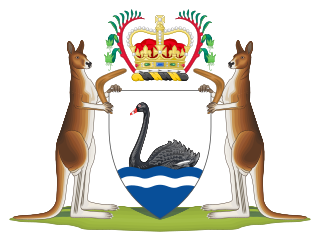
The coat of arms of Western Australia is the official coat of arms of the Australian state of Western Australia. It was granted by a royal warrant of Elizabeth II, Queen of Australia dated 17 March 1969.

The coat of arms of Australia, officially the Commonwealth Coat of Arms, is a formal symbol of the Commonwealth of Australia. It depicts a shield, containing symbols of Australia's six states, and is held up by native Australian animals, the kangaroo and the emu. The seven-pointed Commonwealth Star surmounting the crest also represents the states and territories, while golden wattle, the national floral emblem, appears below the shield.
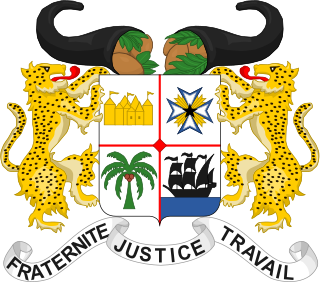
The coat of arms or national seal of Benin, originally introduced in 1964, was readopted in 1990 after being replaced in 1975.
In heraldry, an ordinary is one of the two main types of charges, beside the mobile charges. An ordinary is a simple geometrical figure, bounded by straight lines and running from side to side or top to bottom of the shield. There are also some geometric charges known as subordinaries, which have been given lesser status by some heraldic writers, though most have been in use as long as the traditional ordinaries. Diminutives of ordinaries and some subordinaries are charges of the same shape, though thinner. Most of the ordinaries are theoretically said to occupy one-third of the shield; but this is rarely observed in practice, except when the ordinary is the only charge.
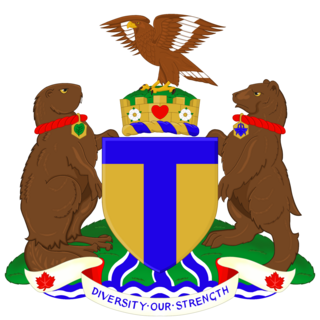
The coat of arms of Toronto is a heraldic symbol used to represent the city Toronto. Designed by Robert Watt, the Chief Herald of Canada at the time, for the City of Toronto after its amalgamation in 1998. The arms were granted by the Canadian Heraldic Authority on 11 January 1999.

The coat of arms of Victoria is the official heraldic symbol of the Australian state of Victoria. Victoria was the second state of Australia to gain arms, granted on 6 June 1910 by royal warrant of King George V. The state had been named in 1851 after his grandmother, who reigned at the time. The current version of the arms was granted 28 March 1978 in the royal warrant issued by Queen Elizabeth II.

The coat of arms of Sunderland is the official heraldic arms of the City of Sunderland in England.

The coat of arms of Brisbane is the official coat of arms of the city of Brisbane. It was first adopted in 1925 and draws much of its symbology from Sir Thomas Brisbane, for whom Brisbane was named.

The coat of arms of Denmark has a lesser and a greater version.

The coat of arms of Sierra Leone, were developed by the College of Arms and granted in 1960.

The coat of arms of Namibia is the official heraldic symbol of Namibia. Introduced at the time of independence in 1990, it superseded the earlier coat of arms used by the South African administration of the territory.

The coat of arms of Cape Town is the traditional symbol of the municipality of Cape Town. The original arms from the 20th century are no longer in official use, though no new arms have yet been adopted.

The Coat of arms of West Yorkshire Metropolitan County Council was granted in 1975 to the new Metropolitan county council created in the previous year. The County Council was abolished in 1986 under the provisions of the Local Government Act 1985 and consequently the arms are no longer used. The current West Yorkshire Combined Authority uses a wordmark consisting of the authorities name.

The coat of arms of Kropyvnytskyi is one of the city's symbols reflecting its past and the controversies of its history.

The coat of arms of Sint Eustatius consists of a shield and the motto. It was established on 9 November 2004 by the Island council of Sint Eustatius, when it was still part of the Netherlands Antilles. It remained the coat of arms of Sint Eustatius after the dissolution of the Netherlands Antilles and the subsequent change of Sint Eustatius's constitutional status into a special municipality of the Netherlands in 2010.
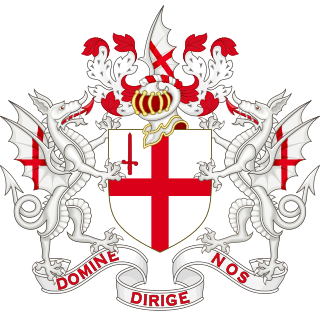
The coat of arms of the City of London is the official coat of arms of the City of London, England, which is one of a number of cities and boroughs in Greater London.

The coat of arms of the London Borough of Camden were granted on 10 September 1965. The borough was formed by the merger of three former boroughs, namely the Metropolitan Borough of Hampstead, the Metropolitan Borough of Holborn and the Metropolitan Borough of St. Pancras, from whose arms elements were utilised in the arms of the new borough.
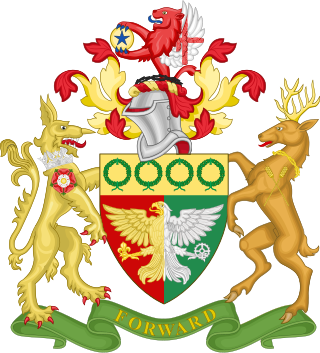
The coat of arms of the London Borough of Hillingdon is the official symbol of the London Borough of Hillingdon. They use elements from the coats of arms of the four previous districts. It is described as:
Arms: Per pale Gules and Vert an Eagle displayed per pale Or and Argent in the dexter claw a Fleur-de-lis Or and in the sinister claw a Cog-Wheel Argent on a Chief Or four Civic Crowns Vert.
Crest: On a Wreath of the Colours issuant from a Circlet of Brushwood Sable a demi-Lion Gules with wings Argent the underside of each wing charged with a Cross Gules and holding between the paws a Bezant thereon a Mullet Azure.
Supporters: On the dexter side an Heraldic Tiger Or gorged with an Astral Crown Azure and charged on the shoulder with a Rose Gules charged with another Argent barbed and seeded proper and on the sinister side a Stag proper attired and gorged with a Circlet of Brushwood and charged on the shoulder with two Ears of Rye slipped in saltire Or.
Motto: Forward.

The Johannesburg municipal council assumed a coat of arms in 1907, and had it granted by the College of Arms on 20 August 1907. The design, by W. Sandford Cotterill, consisted only of a shield : Vert, a fess between three battery stamps Or. The motto was Fortiter et recte.
This page is based on this
Wikipedia article Text is available under the
CC BY-SA 4.0 license; additional terms may apply.
Images, videos and audio are available under their respective licenses.



















